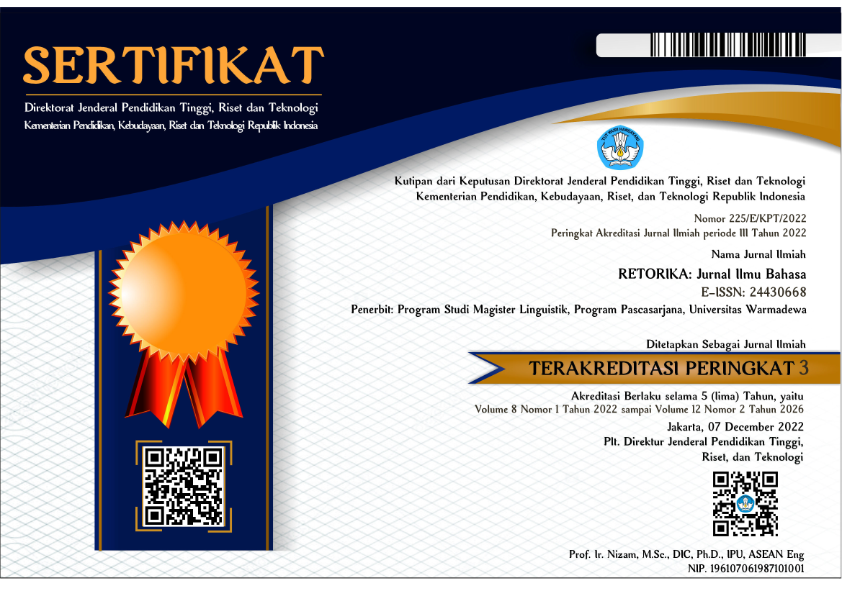The Specific Role of Verb “To Carry†in Balinese
Abstract
A number of studies on verbs as one of the linguistic grammatical categories, serving to desccribe events, have been to explore in depth their more distinct types according to their semantic primitives under the natural semantic metalanguage theory approach. This research aims is to features the semantic types and specific roles of the verb ‘to carry’ in Balinese from the natural semantic metalanguage theory perspective. This study is a qualitative study. The semantic types of the verb in question was first classified in order to ease the identification of their specific semantic roles. The results of research show type of semantic roles were restricted to agent for the arguments serving as an actor of the activity described with the each of semantic type of the verb ‘to carry’ and patient for those serving as target of the said activity. This research discloses a 21 type of Balinese verbs which semantically have an intimate relation to the verb ‘to carry’; they are nèngtèng, ningting, nyangkol, nyangkil, nyuun, negen, ngandong, nenggolong, nyelet, nyelepit, ngabin, nampa, ngundit, nangal, nandan, nyekel, nikul, ngenyang, mundut, nyunggi, dan ngayot.References
Alwi, H., Dardjowidjodjo, S., Lapoliwa, H., & Moeliono, A. (1993). Tata Bahasa Baku Bahasa Indonesia. Jakarta: Departemen Pendidikan Dan Kebudayaan.
Arifin, Zaenal, & Junaiyah. (2009). Morfologi, Bentuk, Makna, dan Fungsi. Jakarta: PT Gramedia Widiasarana Indonesia.
Artawa, I. K. (2004). Balinese language: A Typological Description. Denpasar: CV. Bali Media Adhikarsa.
Ayatrohaedi. (1979). Dialektologi: Sebuah Pengantar. Jakarta: Jakarta: Pusat Pembinaan Dan Pengembangan Bahasa Departemen Pendidikan dan Kebudayaan.
Booij, G. (2007). The Grammar of Words. Oxford: Oxford University Press.
Crystal, D. (1985). A First Dictionary of Linguistics and Phonetics. Colorado: Westview Press.
Goddard, C. (1996). Semantic Theory and Semantic Universal. Australia: Cross Linguistic Syntax from Semantic Point of View.
Parwati, S. A. P. E. (2018). Verba “Memasak†dalam Bahasa Bali: Kajian Metabahasa Semantik Alami (MSA). Aksara, 30(1), 121–132.
Purwati, I. A. M., Indra, I. B. K. M., Granoka, I. W. O., & Dhanawaty, N. M. (1996). Frasa Verbal Bahasa Bali. Jakarta: Pusat Pembinaan dan Pengembangan Bahasa Departemen Pandidikan dan Kebudayaan.
Saputra, I. M. D. (2017). Verba ‘Memukul’ dalam Bahasa Bali. PRASI, 12(01), 35–44.
Sudipa, I. N. (2012). Makna “Mengikat†Bahasa Bali: Pendekatan Metabahasa Semantik Alami. Jurnal Kajian Bali, 02(Oktober), 49–68.
Van Valin, R. D., & LaPolla, R. (1997). Syntax: Structure, Meaning, and Function. Cambridge: Cambridge University Press.
Warna, I. W. (1990). Kamus Bali Indonesia. Denpasar: Dinas Pendidikan Dasar Provinsi Dati I Bali.
Widani, N. N. (2016). Makna “Mengambil†Bahasa Bali : Pendekatan Metabahasa Semantik Alami (Msa). Retorika: Jurnal Ilmu Bahasa, 2(1), 127–141. https://doi.org/10.22225/jr.2.1.242.124-137
Wierzbicka, A. (1996). Semantics: Primes and Universals. New York: Oxford University Press.
Winaya, M. D. (2016). Jenis-Jenis Inkorporasi Pelesapan Verba dalam Bahasa. Retorika: Jurnal Ilmu Bahasa, 2(1), 64–78. https://doi.org/10.22225/jr.2.1.224.63-76
Zaim, M. (2014). Metode Penelitian Bahasa: Pendekatan Struktural. (Ermanto, Ed.). Padang: Penerbit FBS UNP Press Padang
Copyright (c) 2019 RETORIKA: Jurnal Ilmu Bahasa

This work is licensed under a Creative Commons Attribution-ShareAlike 4.0 International License.
This journal provides immediate open access to its content on the principle that making research freely available to the public supports a greater global exchange of knowledge.
All articles published Open Access will be immediately and permanently free for everyone to read and download. We are continuously working with our author communities to select the best choice of license options, currently being defined for this journal as follows: Creative Commons-Non Ceomercial-Attribution-ShareAlike (CC BY-NC-SA)
 Abstract viewed = 244 times
Abstract viewed = 244 times
 PDF downloaded = 234 times
PDF downloaded = 234 times

2.png)














